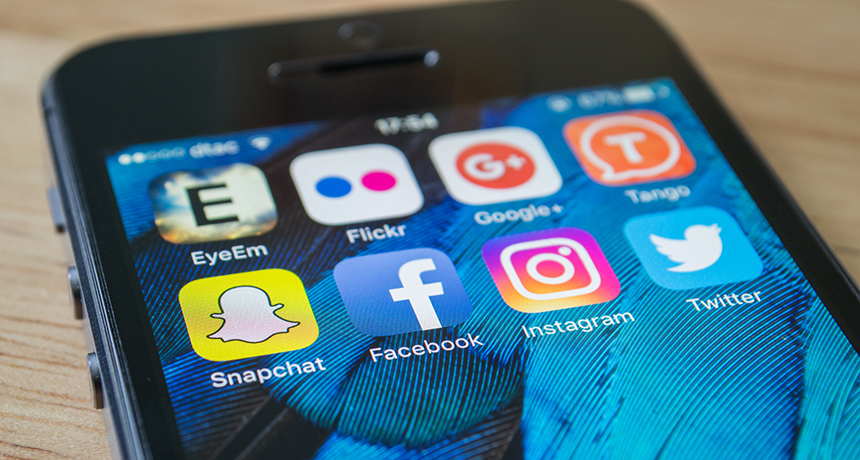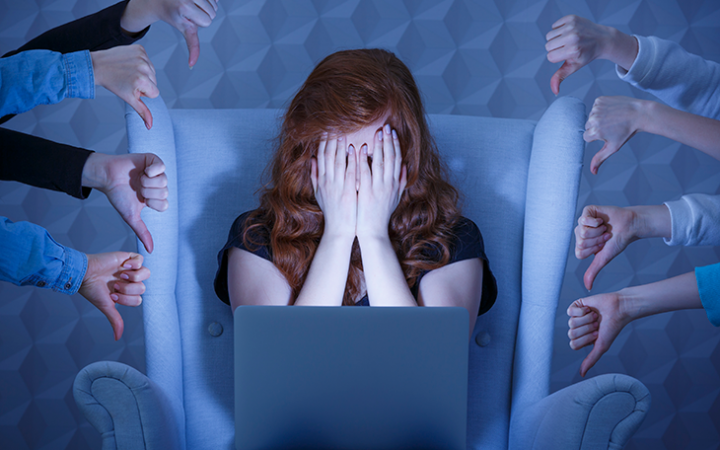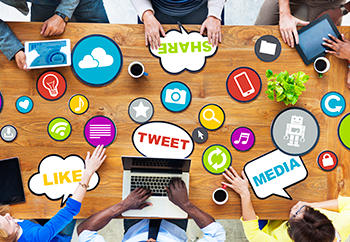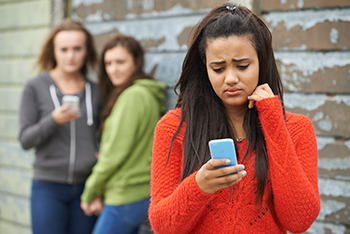Social media: What’s not to like?
Social media can boost teens’ self-esteem — or foster depression

Connecting with people online can be easy, fun and almost addictive. But linking up with others in the digital world also can have drawbacks. Users need to recognize in advance that not all online posts will be positive (for you).
Wachiwit/iStockphoto
This is the first of a two part series
Teens sneak a peek at the internet every chance they get. In fact, the average U.S. teenager spends almost nine hours a day on digital devices. Much of that time is on social media, such as Instagram, Snapchat and Facebook. The sites have become important places for students to interact. But sometimes these connections lead to disconnections.
Using social media to connect with others is kind of like having a private conversation in a public place. But there’s a difference. Even when you’re chatting with a friend in the middle of a physical crowd, most other people can’t hear what you say. On social media, your conversations can be read by anyone with access. Indeed, posts on some sites are publicly available to anyone who looks for them. Elsewhere, people can limit who has access by adjusting their privacy settings. (But even many private profiles are fairly public.)
Depending on whether people notice your posts — and how positively they respond — your online interactions may be quite positive. Or not. Social media can make some teens feel depressed and isolated. They can feel cut out of social interactions. They may feel judged. In fact, people who visit social media sites to feel connected to friends may end up caught in online drama, or even cyber-bullying.
But being glued to your phone or engrossed in a Snapchat story isn’t all bad. Social media provides an important place for people to connect. The feedback that users get from their peers can boost self-esteem. And social media can even boost relationships among family members.
A filtered view
The average teen has about 300 online friends. When people post to their social media account, they’re speaking to that large audience — even if their posts aren’t publicly available. That same audience can see the responses other people provide through comments or “likes.”

Those likes and comments influence the kinds of posts teens put up — and leave up. A 2015 study by researchers at Pennsylvania State University in University Park found that teens were more likely than adults to remove Instagram posts within 12 hours of posting. They took down posts that had few likes or comments. This suggests that teens try to make themselves look good by only keeping up popular posts.
Peer feedback plays a big role in how teens view themselves and each other, note Jacqueline Nesi and Mitchell Prinstein. These psychologists at the University of North Carolina in Chapel Hill study how teens use social media.
More than adults do, teens present idealized versions of themselves online, the researchers find. Teens may only share photos that show them having fun with friends, for example. This filtered view of their lives makes others believe all is well — even when it’s not.
All teens compare themselves to others. That’s an important part of figuring out who you are as you grow up. But social media makes this experience more extreme. You can actually measure how popular a person or a photo is, for example. And those carefully crafted profiles can make it feel like everyone else is living a better life than you are.
Students’ use of social media “may form distorted perceptions of their peers,” Nesi says. Teens compare their own messy lives to the highlight reels that their peers present. This can make life feel unfair.
Such comparisons can be a problem, especially for unpopular people.
In a 2015 study of eighth- and ninth-graders, Nesi and Prinstein found that many teens who used social media experienced symptoms of depression. That was particularly true for those who were unpopular. Nesi speculates that unpopular teens may be more likely than popular kids to make “upward” comparisons. Those are comparisons with someone who seems better in some way — more popular, for example, or wealthier.
Those findings fit with previous studies that found unpopular teens get less positive feedback on their posts. That may happen because they simply have fewer real-life friends — and therefore fewer online connections. Or it may have to do with the types of things those teens post. Other researchers have found that unpopular teens write more negative posts than their peers. These people are more likely to post about unhappy events (such as having a phone stolen) than happy ones. Together, these factors can lead to low self-esteem and symptoms of depression.
Story continues below image.

More popular teens, however, don’t tend to become depressed or lose self-esteem. “They are more likely to make ‘downward’ comparisons with others, feeling superior to those whose profiles they review,” Prinstein says. “Fair or not, they tend to have more online friends and more activity on their feeds, making them feel popular online too.”
Prinstein urges teens to get help for friends who seem depressed. “Teens who seem to be sad or irritable for a period of two weeks or more may be experiencing depression,” he says. This is especially true if they’ve also lost interest in activities that used to be fun, or if their sleeping or eating habits also have changed.
It’s important for students who notice a friend acting this way to encourage that friend to get help. “One of five girls and young women will experience a major depressive episode by the age of 25,” Prinstein says. “Almost one in 10 will seriously consider suicide before they graduate high school,” he adds.
A place to connect
Social media sites are important places to socialize, observe Alice Marwick and danah boyd. Marwick is a culture and communications researcher at Fordham University in New York City. boyd is a social media researcher at Microsoft Research, also in New York.
The two interviewed hundreds of teens from across the United States. Since teens spend so much of each day connecting online, many adults worry that kids no longer know how to communicate in person. In fact, boyd and Marwick found the opposite was true.

Teens want to hang out together, boyd says. Social networks let them do that, even when their lives are too busy — or too restricted — to meet up in person. Even teens who have the time and freedom to hang out with their friends may have a hard time finding places to do so. Teens used to head to malls, movie theaters or parks. But many of these places discourage kids from hanging out. Changes like these make it much harder for teens to keep up with each others’ lives. Social media can help to fill that gap.
But, the researchers add, there are important differences between hanging out on social media and spending time together in person.
Unlike a face-to-face conversation, online interactions can stick around. Once you post something, it’s out there for the long term. Even posts you delete aren’t always gone for good. (Think you’re in the clear with Snapchat, where every post disappears after 10 seconds? Not necessarily. Those temporary posts may stick around if someone takes a screenshot before they vanish.)
Depending on someone’s privacy settings, certain social media posts can be visible to anyone who scrolls or clicks around enough. Sites such as Facebook are also searchable. Some users may be able to easily share a post you make, spreading it beyond your control. And teens (and adults) who connect with people from different areas of their lives might run into awkward moments — like when a friend leaves a joking comment on your post that your grandmother doesn’t find funny at all.
Online ‘drama’
Those features can lead to what teens might call “drama.” Marwick and boyd define drama as conflict between people that is performed in front of an audience. Social media seems to turn up the drama. That’s because others can watch the performance simply by hopping online. And they can encourage that drama by liking particular posts or comments.

Online drama, and the attention it attracts, can be hurtful. But the teens that boyd and Marwick interviewed usually did not call these interactions “bullying.”
“Drama is a word that teens use to encompass a lot of different behaviors,” Marwick says. “Some of these behaviors might be what adults call bullying. But others are pranks, jokes, entertainment.” Bullying, she notes, takes place over a long time and involves one teen exerting power over another.
Calling these behaviors drama “is a way for teens to avoid the language of bullying,” she notes. Bullying creates victims and perpetrators. Teens don’t want to be seen as either. Using the term “drama” removes those roles. It “allows them to save face even when drama is hurtful,” Marwick says.
Such hurtful interactions can lead to depression, long-term mental-health problems or even suicide. Teens use the word “drama” to minimize serious behavior by their peers. So it’s important for both adults and other teens to listen when teens talk about drama, Marwick says. Recognizing bullying — and stopping it — might just save a life.
Keeping it in the family
Social media is not just for teens, of course. People of all ages interact on Facebook, Snapchat and more. Indeed, many teens “friend” family members, including their parents, notes Sarah Coyne. She is a social scientist at Brigham Young University in Provo, Utah. Such online relationships can actually improve family dynamics at home, she observes.

In one 2013 study, Coyne and her colleagues interviewed families with at least one 12- to 17-year-old. Interviewers asked about each family member’s social-media use. They asked how often family members communicated with each other on these sites and how connected each felt to the others. They also probed other behaviors. For instance, how likely were the participants to lie or cheat? Did they try to hurt people with whom they were angry? And how likely they were to make kind gestures online toward family members.
About half of these teens connected with their parents on social media, it turns out. Most didn’t do so every day. But any social-media interaction made teens and parents feel more connected. This may be because families could respond to posts with likes or words of encouragement, Coyne says. Or perhaps social media gave parents a more in-depth look at their children’s lives. That helped parents better understand their kids and what they were going through.
This sense of connection might have other benefits, too. Teens who connected with their parents online were more likely to help out family members. They were less likely to lash out at them when angry. And kids were less likely to feel depressed or to attempt to lie, cheat or steal.
The relationship between online connections and better behavior is a correlation, Coyne points out. That means she doesn’t know what causes what. It’s possible that friending their parents makes teens behave better. Or perhaps teens that friend their parents are already better-behaved.
Using social media can have real benefits, Prinstein says. It lets us connect with new friends and stay in touch with old ones. Both of these activities can make other people like us more, he says. And that “has been shown to have long-term benefits for our happiness and success.”
Unfortunately, many people tend to get caught up in other aspects of social media. They focus on how many likes or shares they have, or how many people see their posts, Prinstein says. We use these numbers to measure our status. “Research shows that this kind of popularity leads to negative long-term outcomes,” he says. Studies that measure changes in behavior over time suggest that people who are too focused on these measures of popularity can begin to drink or use drugs. They can become more aggressive. And they’re unhappier in their relationships, he says.
It’s easy to get dragged into the drama and other negative aspects of social media. But between strengthening family ties, boosting self-esteem and maintaining friendships, there’s a lot to like about these online interactions.
Suicide is the second leading cause of death among young adults ages 15 to 29 as of 2016. If you or someone you know is suffering from suicidal thoughts, please seek help. In the United States, you can reach the Suicide Crisis Lifeline by calling or texting 988. Please do not suffer in silence.
Next: The power of ‘like’







